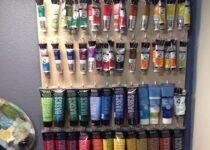Does the paint dry darker or lighter?
Multiple factors might impact whether a freshly painted wall seems lighter or darker shade than intended. How much darker or lighter does the paint get once it has dried?
Does the paint dry darker or lighter?
Colours may appear darker or lighter depending on the setting and type of paint used. Painting over lighter-coloured paint will make it look darker, and vice versa. There are paint treatments like a gloss that reflects light, making the colour darker than it is. Light will reflect off the paint, making it appear lighter.
When the paint dries, it does not get brighter or darker. Paint may seem lighter or darker during the application, but high-quality paint must always cure the colour specified on the paint box lid or colour swatch.
You may think that the paint has fully dried in a different colour because of the variables listed below. Once the paint has fully dried on a wall, many individuals say to themselves, “Hey, this is not the colour I wanted! ” Despite this, the answer is straightforward.
The paint on a recently painted home wall is still moist. The retailer’s colour swatch does not match this particular wet type paint. Basically, this is the “wet” type of it. The solvent in all paints, whether oil based or water-based, evaporates when applied. When the colour fades entirely, you’ll see your true colour.
A pigment, a binder, & a solvent are all necessary components of a painting. Metallic particles such as titanium dioxide (in white color paint) or iron content (in orange/red paint) make up the pigment, which gives the paint its colour.
Allows the pigment/binder combination to spread uniformly and dry rapidly by using a solvent. Importantly, until the paint dries, the solvent will alter its colour. Why?
The pigment appears darker because water or oil solvent particles absorb or refract light, preventing light from reaching the pigment. However, once dried, the solvent would be no longer present, & the pigment may absorb & reflect light to get its natural colour, which is identical to the retailer’s colour swatch.

It has the appearance of a wet T-shirt that is becoming darker. When it dries, the colour returns to normal. Paintworks in the similar way, so follow the steps below which would ensure that your paint is properly mixed and dries to the desired colour:
- Interior paints should only be combined with paints from the same manufacturer.
- Always thoroughly blend the paint.
- Use the paint store’s available mixers for the best results.
- Allow the paint to dry completely after testing it on a smaller and less significant area.
Which Paints are Likely to Dry in Darker shade?
Oil along with acrylic, & latex paints are known for drying in darker shade than their initial color. you can check out more about latex vs acrylic paints on our guide to better understand the difference and their advantages. However, remember that if the paint is blended correctly, the resulting color would match the swatch. Furthermore, the light which is reflected from glossy surfaces can cause glossy or quality semi-gloss paints to seem darker as they dry.
Because of the more decadent finish, it is usually assumed that such paints require just a single coat. This assumption, however, is false and may result in conflicting results. Always apply two coats of paint, regardless of the quality of the paint used. This ensures that there are no left over streaks or gaps in the appearance of the darker shade paint.

Which Paint types are Likely to Dry Lighter?
It is well known that cream color or white paints dry in lighter tone than they seem. The bulk of these colors, in actuality, are intended to seem organically subdued.
On the other side, watercolors appear to fade paint after complete drying. This is due to the high water content of these paints, which dilutes the color. You may also change paint base color to get a brighter or dark color look. Darker colors are typically produced using tint base palettes with light color shade paint.
A dark foundation tone, on the other hand, will generate brighter color.
Paints That Stay real to Their Color
Latex based paints remain like their original color if allowed a reasonable drying period of 8 hours. You would acquire the appropriate paint color regard less of the number of paint coats applied. Latex based paint is a terrific choice for painting for different reasons. Firstly, it may be used and provides some of the most beautiful paint finish.
Besides that, you can rapidly mop the wet paint that might have dripped on your house floors. While buying this type of paint, you should reconfirm from the swatch colors & opt for a splendid matte finish. It would not absorb the light, giving your walls the precise shade that is seen on the shade card.
Factors that influence how a paint color dries
If you’re worried that the color you chose, a deep maroon, will appear brilliant red on your walls, don’t be. You should be happy with the results if you mixed the paint correctly, applied enough coats, and allowed enough drying time.
If it doesn’t appear to be a perfect match, you haven’t given it enough time to dry, you haven’t applied enough coats, or someone made a mixing error that you should try to correct. Here are some more variables that may affect the color of your paint as it dries.

Environment
The appearance of color may be altered by various factors, including the presence of plants, pictures, furniture, and even surrounding walls. Test out a couple of color swatches on your walls before you go out and buy a whole new gallon of paint to ensure that you got a color scheme that flows well together.
Finish
The use of various coatings results in observable and noteworthy aesthetic differences. Because this kind of paint scatters light, vast sections of a wall that has been completed with glossy paint may appear darker than was intended. A matte or eggshell finish will, in most cases, give the impression of being more comparable to the color swatch you select. Paints with a quality flat finish have a chalkier appearance and less shine than paints with a gloss finish. To guarantee that the final result will be consistent with the swatch, pay particular attention to the paint finish you select.
Lighting
It is essential that the paint’s surface is smooth to the touch and that it reflects the surrounding natural light. It’s crucial that every room in the house has enough natural light and looks good with the others. Changing the light sources can affect the sheen and gloss, notably darker colors. If the color isn’t quite perfect, consider adjusting the light sources.
Temperature
The paint reacts quite differently depending on the temperature. At lower temperatures, paint takes on a more dense consistency, whereas, at higher temperatures, it wrinkles or changes shape. For optimal results, painting should be done at temperatures ranging from 35 to 100 degrees Fahrenheit and low humidity. It’s possible that this won’t change the color, but it might result in unattractive paint chips, bubbles, and fractures, eventually leading to paint flaking off.
Tip: Getting color samples from a paint provider and testing them out on your walls are two things you should do before settling on a color for your walls. It is essential to carefully paint the sample on many walls so that you can observe how the sun changes the undertones of the color. You could find out that the color you loved most on the swatch is not your top choice.
How Does mental Factors Influence Paint Color?
You have undoubtedly witnessed an occurrence in which your eyes tricked you for choosing. Metamerism seems to be the scientific word for it. It is a psychophysical phenomenon in which diverse colors appear to the viewer under various settings.
When choosing paint colors at a local paint store, you immediately compare them to different options in the vicinity. Rather than a single hue, we commonly see the next vibrant color on a color wheel.
To obtain the most realistic feeling of color, study it independently using a large swatch or quality paint sample. You could also check it against a white color backdrop or your trim color. This should produce the most realistic representation of chosen color.
you can also paint your craft work like glitter fruits to make them more vibrant and good looking with different paint types for testing which suits your interior and exteriors the best.
Useful Tips For Choosing Interior Paint Colors
Now once you have understood the components that influence how we perceive a quality paint color after it has dried, it is time to pick your colors. Choosing the right color may be a difficult and frightening process.

However, the following recommendations will help you pick colors for interior paint:
- Take cues from the current colors in your room. figure the space you want to color paint & take note of the colors that are already there. Choose a paint color that complements all of the room’s colors, whether from quality furniture or stunning décor.
- Choose the sentiment you want to elicit. Consider how you want the room to feel overall, as well as how you wish your guests to feel when choosing a new color. A place meant to imply calm will have a very variable paint color than one designed to evoke bustle. eg baby room should have vibrant colors and patterns like colorful baby costume and toys to make it more lively for the new kid which could make the more receptive to inculcating creativity at various levels in the lifetime growing up.
- Consider the room’s purpose. Considering the purpose of the room may help you choose the appropriate paint color for it. Consider how you will spend most amount of your time in this area if you remodel a living room. Will you be entertaining guests or keeping your youngsters occupied or just relaxing?
- Take a look at the illumination. As previously said, this is critical, & lighting in a place significantly impacts paint color. Applying large color swatches to your area’s walls might help you evaluate how the lighting in the room will affect the hue.
- Very concentrated paint colors should be avoided. While there is nothing as a terrible paint color, it may be difficult to match a space with extremely bright or saturated tones. Choose a toned-down version of highly saturated shade you are drawn to instead.
- Maintain simplicity. When in the doubt about color picking, stick to a simple yet elegant color scheme. This ensures that the wall color does not clash with the room’s prominent points. Generally, you should maintain your color palette to 3 to 5 tones.
Will UV Damage Make Exterior Paint Lighter?
Instead of making it appear lighter, ultraviolet radiation causes paint to fade over time. The pigment in the paint that is fading has been transformed into entirely other colors due to the action of an external agent. A paint that “appears” to be brighter is only being influenced by anything from the outside.
Tips for Avoiding Darker or Lighter color Than Expected Paint
Below shared are some suggestions for avoiding unexpectedly dark or light paint. This is not an exhaustive list, but you should make these considerations before your next house painting endeavor.
- Invest in premium paint; you get what you have payed for.
- Always try to paint at temperatures over 60 deg Fahrenheit.
- must employ a primer.
- Ensure the relative humidity is below 70 percent & preferably around 50 percent.
- Before using, properly combine your paint.
- Avoid base hand touching up your paint when its wet; if required, repaint the entire wall.
FAQs
-
Is the paint getting darker tones as it dries?
- Yes, it is commonly considered that paint darkens as it dries. This, however, is false. Any painting of exceptional quality keeps its original color regard less of the number of paint coats applied. In contrast, low-cost paints might dry darker than you would expect.
-
Is the paint on the wall darker?
- Yes, if the wall was painted before in bright hues, the paint will make it look darker. Furthermore, a variety of things may influence the finale look. The sheen of glossy paint may reflect light, making the color looks darker than the color look on the swatch.
-
How much time does it takes for paint to dry out to its actual color?
- The drying time may differ based on the type of paint used. Latex based paint dries quickly to the touch and maybe reapplied four hours later. Similarly, oil based paints take six to eight hours to dry for the touch. After 24 hours, they can be safely recoated.
-
Why is the wall repair paint darker?
- Because it has fewer water particles and more pigment, wall touch-up paint may seem darker. Long-term paint storage can induce moisture loss, resulting in a bit of darkening. you will find similar properties of dark paint appearance if you paint on the wood deck before removing staining, but after cleaning it will be lighter on 1st and 2nd coats.
-
Does the paint dry from top to bottom?
- Because there are fewer solvent vapors on the surface, the paint will dry from the top down. Paint solvent evaporates in the environment, sinks, and collects at the bottom due to its weight. As a result, the paint on the bottom half of the wall will dry slowly.

Being associated with art and craft field since decades as a hobbyist and life long learner has given me an opportunity to learn many new things related to art, craft, paints and pottery which i am trying to share with your guys on this website. I have expertise of being professional painter and potter for the last 20+ years
I have learned mind blowing cool tips and insights which makes me a person with ability to improvise and come up with creative ideas and solutions to make stunning and impeccable art pieces of all types which are adored by people across the globe on this website and other platform.


